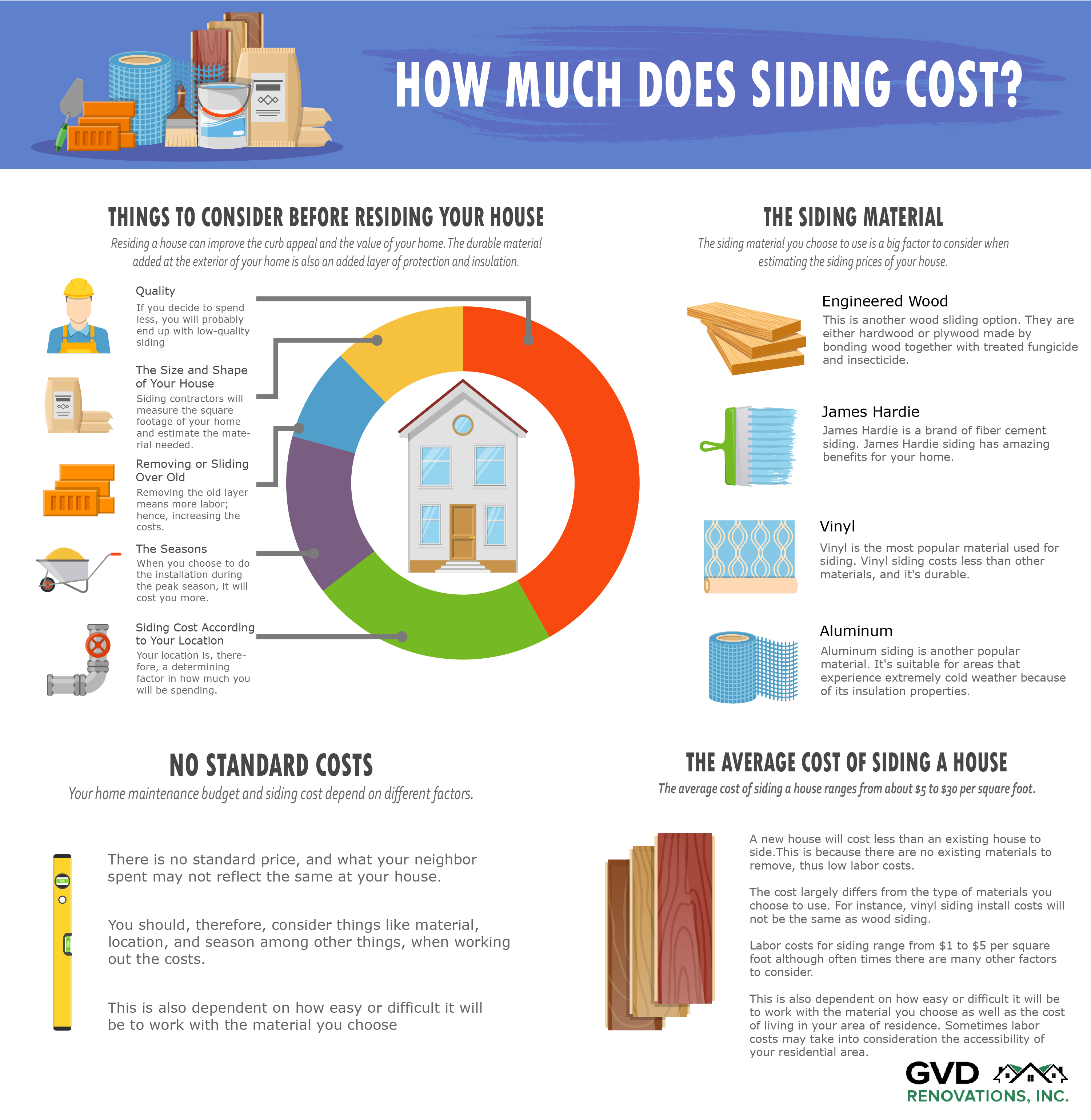Introduction
As a homeowner, maintaining the exterior of your house is crucial. Siding serves as an essential protective barrier against the elements, enhancing both aesthetic appeal and energy efficiency. However, over time, siding can deteriorate due to weathering, damage, or fading. Replacing siding can be a significant home improvement project, and understanding the associated costs is essential for budgeting and planning purposes.

Image: www.gvdrenovationsinc.com
This comprehensive guide will explore the factors that influence the cost of siding replacement, provide detailed estimates, and offer tips to help you make informed decisions about your siding project.
Factors Affecting Siding Replacement Costs
1. Material Type
The most significant factor affecting the cost of siding replacement is the material used. Popular siding options include vinyl, fiber cement, aluminum, wood, and steel. Each material has unique properties, durability, and price range.
- Vinyl Siding: Affordable, durable, and easy to maintain, making it a popular choice for cost-conscious homeowners.
- Fiber Cement Siding: Durable and fire-resistant, resembling the look of wood without the upkeep. It is more expensive than vinyl but offers greater longevity.
- Aluminum Siding: Lightweight, rust-resistant, and energy-efficient. It is more expensive than vinyl but requires less maintenance.
- Wood Siding: Classic and natural, but requires ongoing maintenance to protect against rot and insects. It is the most expensive siding option.
- Steel Siding: Durable, weather-resistant, and fire-resistant. It is more expensive than aluminum but offers exceptional protection.
2. Labor Costs
The complexity of the siding installation and the labor rates in your area will impact the labor costs associated with siding replacement. Factors such as the height of the house, intricate architectural details, and accessibility will affect the overall labor time and expenses.

Image: www.fixr.com
3. Project Size
The square footage of the exterior surface being replaced will directly influence the cost of siding material. Larger homes with more surface area will require more materials, increasing the total cost.
4. Removal and Disposal
If the existing siding needs to be removed before installing new siding, additional costs will be incurred for labor and disposal fees. The cost of removal will vary depending on the material and the amount of siding being removed.
5. Other Factors
Additional factors that may affect the cost of siding replacement include:
- Flashing and trim installation
- Inspection and permits
- Scaffolding or special equipment
- Seasonality and availability of materials
Estimated Siding Replacement Costs
The average cost of siding replacement can vary widely depending on the factors discussed above. However, based on industry averages, here are approximate estimates for different materials:
| Siding Material | Average Cost per Square Foot | Average Cost for a 2,000 Square Foot House |
|---|---|---|
| Vinyl Siding | $4-$10 | $8,000-$20,000 |
| Fiber Cement Siding | $6-$15 | $12,000-$30,000 |
| Aluminum Siding | $8-$18 | $16,000-$36,000 |
| Wood Siding | $10-$30 | $20,000-$60,000 |
| Steel Siding | $12-$25 | $24,000-$50,000 |
Tips for Saving on Siding Replacement
- Consider DIY installation for certain siding materials, such as vinyl or aluminum, to save on labor costs.
- Compare quotes from multiple contractors to ensure you are getting the best price.
- Utilize discounts and promotions offered by siding manufacturers or contractors.
- Explore financing options to spread the cost of siding replacement over time.
Expert Advice for Siding Replacement
For optimal results, consider the following expert recommendations:
- Choose a reputable contractor: Hire an experienced and licensed contractor with a proven track record of quality workmanship.
- Plan ahead: Allow sufficient time for the siding replacement project to be completed efficiently and without disruptions.
- Inspect the existing siding: Thoroughly examine the condition of the current siding to determine the extent of repair or replacement required.
- Follow building codes: Ensure that the siding installation complies with all applicable building codes and standards.
FAQ on Siding Replacement
Q: How long does siding replacement typically take?
A: The duration of siding replacement varies depending on the size of the house, complexity of the project, and weather conditions. It generally takes anywhere from one to four weeks.
Q: Can I replace siding without removing the old siding?
A: In some cases, it may be possible to install new siding over the existing siding, known as a “siding overlay.” However, this option is not always recommended and may limit your choice of materials.
Q: What maintenance is required for siding?
A: Different siding materials have varying maintenance requirements. Vinyl siding typically requires occasional cleaning, while wood siding needs regular painting or staining to protect against moisture and decay.
How Much Does Siding Cost To Replace
Conclusion
Replacing siding is a significant investment that can enhance the beauty, durability, and energy efficiency of your home. By understanding the factors that influence the cost of siding replacement, being informed about the materials and installation process, and following expert advice, you can make wise decisions that will yield lasting benefits for your property.
Are you facing concerns about the condition of your siding? Don’t hesitate to contact a reputable contractor for a professional evaluation and to explore the best options for siding replacement that meet your needs and budget.